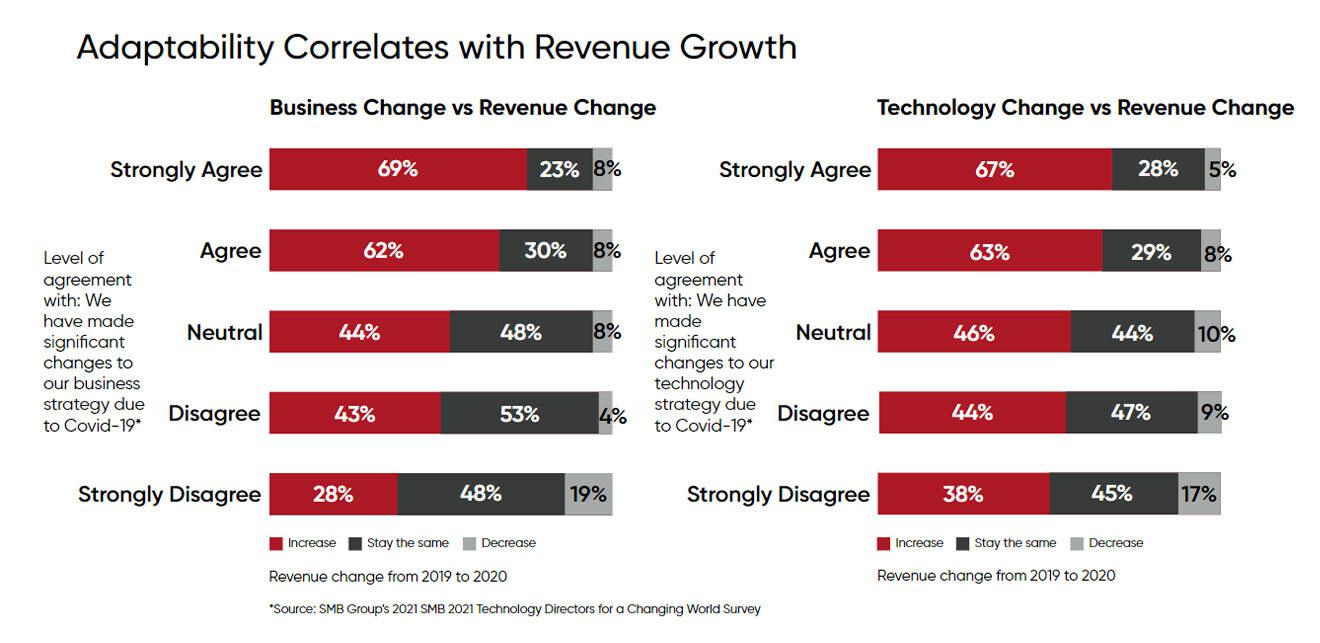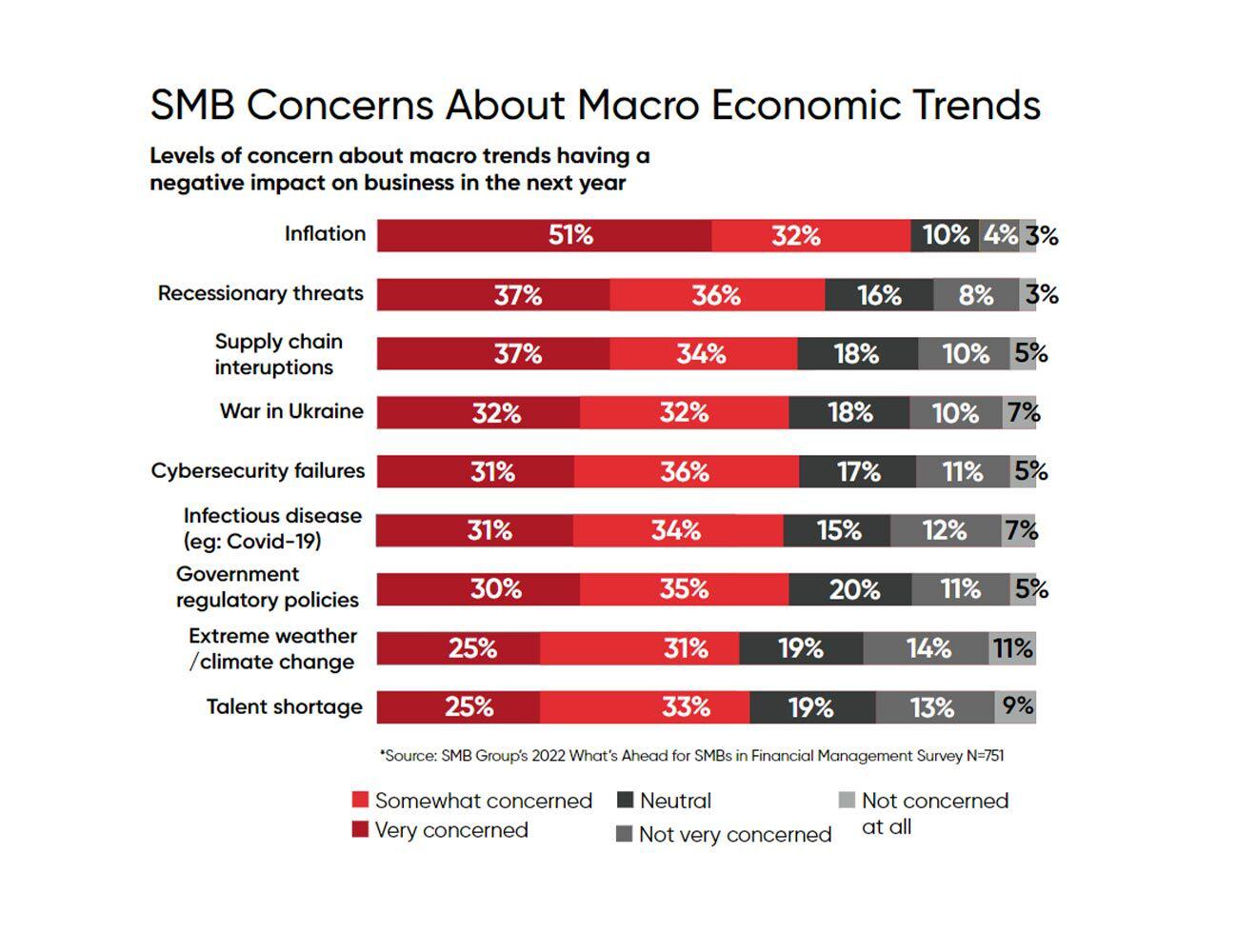Home > Blog
Read Time — 7 minutes
Preparing Your Business to Thrive in Uncertain Times

If we’ve learned anything over the past couple of years, it’s that’s business complacency is a dangerous thing—and that being able to respond quickly to change is vital to business prosperity.
The COVID-19 pandemic changed everything in the blink of an eye—underscoring the importance of flexibility. In a world that had suddenly gone virtual, small and medium-sized businesses (SMBs) that were able to use technology to shift to remote work, add and upgrade digital sales and marketing channels, replace physical services with virtual ones, expand supplier and partner channels, and digitize other business processes were more likely to prosper than less agile counterparts.
In 2022, COVID-19 fears are subsiding. But many problems that formed during the pandemic have persisted, and new challenges have also emerged. From inflation to recession, and from supply chain interruptions to the talent shortage, SMBs are concerned about impact these trends could have on their businesses.
As a SMB owner, it’s unlikely that you can control their trajectory. But you can manage how you respond to them. Integrated, cloud-based business management solutions put accurate, up-to-date and complete information at your fingertips—so you can make better decisions about how to guide your business through volatile conditions.
OBSTACLES TO ADAPTING TO CHANGE
However, many SMBs are running their businesses with a jumble of spreadsheets, point solutions, and paper. This approach may work when your business is very small. But once you start to hire more people, expand your customer base, and add more offerings and services, things get complicated—and this approach is likely to become a liability that will stifle growth and hamper your ability to adapt when conditions shift.

Some of the tells that this approach is burdening a business include:
- Spending too much time toggling between different applications and paper to find the information you need: In addition to being very time and labor-intensive, the more often that information is re-entered into different places, the more likely that human errors will occur, and that information will get lost.
- Difficulty getting an accurate, complete and up-to-date view of the business: Having information spread across different applications and spreadsheets makes it almost impossible to see the big picture, and makes it difficult to see what levers to adjust when conditions shift. For instance, if you don’t have about how much you’re spending on different goods or services, how profitable different types of projects are, or how well various marketing campaigns work, it’s tough to make good decisions about where to cut costs or increase spending when circumstances change.
- Too little time to work on innovation and growth: If you’re buried with day-to-day repetitive tasks, it’s hard to find time to develop creative strategies and tactics to stay ahead of change or take time away from the business to recharge.
- Adding new applications compounds information sprawl: If you put an addition onto a cracked or sagging building foundation, you’ll run into problems. The same holds true here. When a new need arises, adding new applications that don’t work with those you already use is likely to just exacerbate the problems discussed above.
BRINGING ORDER TO CHAOS WITH INTEGRATED CLOUD BUSINESS MANAGEMENT SOLUTIONS
Modern, integrated, cloud-based business management solutions offer a clear path forward to streamline operations today, and be better prepared for the future. These solutions typically include many applications to manage and automate financials, distribution, inventory, sales, marketing, and other functions in one, unified platform.
This offers some key benefits, including:
- Time and labor savings through automation: When you automate routine tasks, such as issuing payment reminders, categorizing expenses, managing inventory, and creating sales follow-ups, people can get more done, more quickly. Employees can spend less time on low-value tasks, and more time doing things to grow the business—such as developing new offerings, providing more personalized services, or creating new sales channels. Automation can even replace human labor—such as using robots to scan and stock shelves, or having chatbots to help answer customer inquiries.
- Fewer errors: Capturing information directly from receipts, barcode scans, or your bank dramatically reduces the odds of human errors, and missing information. Once the information is entered, it’s stored in a central repository and flows into all the parts of the business that need it.
- Real-time, holistic information and reporting: When you use a cloud-based solution, information is continually entered and updated in real-time. So, when you run reports, you get current, consistent information across the business—instead of piecemeal information from individual apps. Templates make it easy to create balance sheets, cash flow and income statements, and reports for payroll, inventory, taxes, time tracking and more, all from one system. This makes it easier to evaluate business performance in multiple areas, and to course-correct as needed.
- A better digital experience for customers: Integrated business management suites that include sales, marketing, and customer service functionality make it easier to provide customers with a modern digital experience. Tools to build personalized marketing campaigns, streamline billing and payments, expand payment options, and provide self-service enable your customers to interact and transact with your business online.
GETTING THE BEST FIT FOR YOUR BUSINESS
Many vendors offer cloud-based, integrated management suites aimed at businesses like yours. However, all solutions are not created equal, so it's important to fully evaluate which will work best for you.
Consider the following when assessing different options:
- Vendor definitions of “business size": These often vary wildly. Some vendors define SMBs as businesses with fewer than 100 employees; for others, SMB can extend up to 500, 1000 or even 2,500 employees. Find out if most of the customers using the solutions you are considering are similar to you in terms of employee size, revenues, and resources.
- Functionality and support levels in core offerings: These can also be very different. Some vendors include customer-facing applications in their business management suites, while others don’t. Some include payroll and human resources capabilities, while others don’t. Many sell add-ons and/or partner solutions to augment what’s in the core. Determine your priorities and then assess how different solutions stack up against them.
- Industry-specific functionality: Business management solutions that are built from the ground up for a specific industry are likely to satisfy more of your needs right out of the gate than generic solutions that have just been tweaked for different verticals.
- Affordability: Some vendors make it easy to figure out how much things cost, while others make it more difficult. Vendors that provide clear and transparent pricing are often easier to do business with—and much less likely to surprise you with hidden costs—than those with fuzzy pricing models.
- Ease of deployment and use: Look for information about how long deployments and training take, and how the vendor can help you get up, running and productive more quickly. Ask for customer references who can talk to you about their experiences to help avoid potential “gotchas.”

PERSPECTIVE
Making big changes to your business is always difficult—which is the reason why many businesses stick with technology solutions that they have outgrown. But, the ability to adapt to change has been critical throughout the history of business—and beyond. As Darwin said, ”It is not the strongest of the species that survive, nor the most intelligent, but the one most responsive to change. Now, in our increasingly complex and interconnected world, the pace of change is speeding up—and taking a “business as usual” approach is becoming a recipe for failure.
Putting a solid foundation in place to manage the business is for long-term viability. A unified business management solution can help you automate operations, improve efficiency and productivity, and gain a clear view of what’s going on in the business—all of which put you in a better place to respond to the new challenges and opportunities that will arise in the future.

This article was part of our Winer 2022/2023 Empower Magazine, which features industry thought leaders sharing advice and unique perspectives on how professionals can future-proof their businesses.



